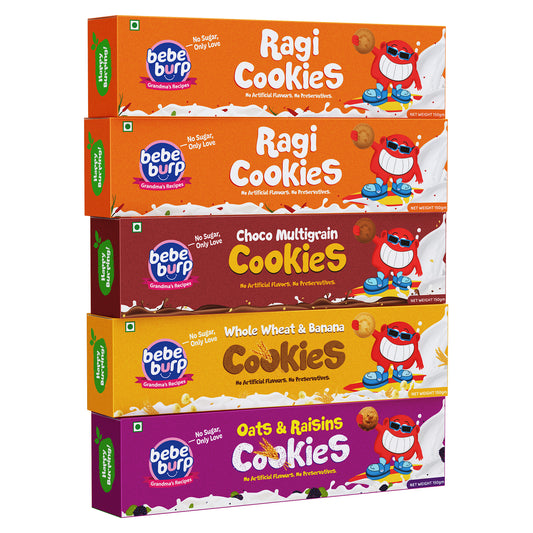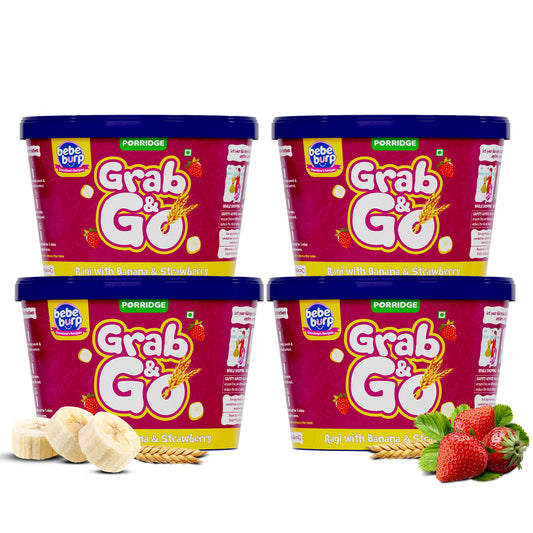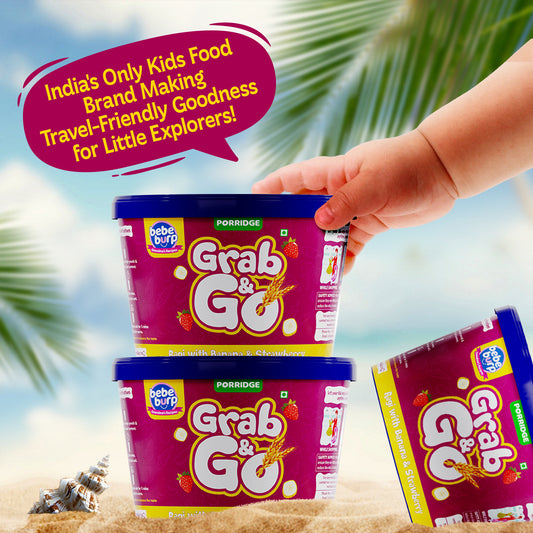INTRODUCTION
The first few years of life are critical for a child's development, and it is important to provide them with a nutritious diet to support their growth and development. Ragi is a gluten-free grain that is a good source of protein, fiber, calcium, and iron. It is a safe and nutritious option for babies, and it can be a good way to introduce them to new and healthy foods.
Ragi is a gluten-free grain that is a good source of protein, fiber, calcium, and iron. It is a safe and nutritious option for babies, and it can be a good way to introduce them to new and healthy foods. Ragi is high in protein, which is essential for babies' growth and development. It is also high in fiber, which can help babies feel full and satisfied. Ragi is a good source of calcium, which is important for babies' bone health. It is also a good source of iron, which is important for babies' blood health.
NUTRITIONAL VALUE OF RAGI FOR BABIES
Here are some of the essential nutrients present in ragi and their significance for baby's growth and development:
- Protein: Ragi is a good source of protein, which is essential for babies' growth and development. Protein helps to build and repair tissues, and it is also important for the production of enzymes and hormones.
- Fiber: Ragi is a good source of fiber, which can help babies feel full and satisfied. Fiber also helps to regulate digestion and prevent constipation.
- Calcium: Ragi is a good source of calcium, which is important for babies' bone health. Calcium helps to build strong bones and teeth, and it is also important for muscle function.
- Iron: Ragi is a good source of iron, which is important for babies' blood health. Iron helps to transport oxygen throughout the body, and it is also important for cognitive development.
- Magnesium: Ragi is a good source of magnesium, which is important for babies' brain development. Magnesium helps to regulate the nervous system and muscles, and it is also important for energy production.
- Zinc: Ragi is a good source of zinc, which is important for babies' immune system. Zinc helps to fight off infection, and it is also important for wound healing.
Here is a comparison of ragi with other grains commonly introduced to babies:
|
Grain |
Nutrients |
Gluten-free |
Pros |
Cons |
|
Ragi |
Protein, fiber, calcium, iron, magnesium, zinc |
Yes |
High in nutrients, versatile, easy to cook |
Can be difficult to find, has a strong flavor |
|
Oats |
Protein, fiber, iron, magnesium |
Yes |
High in fiber, easy to digest, low in allergens |
Can be bland, can be processed |
|
Quinoa |
Protein, fiber, iron, magnesium, zinc |
Yes |
High in nutrients, versatile, easy to cook |
Can be expensive, has a slightly bitter taste |
|
Wheat |
Protein, fiber, iron, magnesium, zinc |
No |
Widely available, affordable, versatile |
Can be difficult to digest for some people, contains gluten |
WHEN AND HOW TO INTRODUCE RAGI TO BABIES
When it comes to introducing ragi to babies, it is important to consider the age-appropriate time to start. Generally, ragi can be introduced to babies around six to eight months of age. At this stage, babies have usually started consuming solid foods and have developed the ability to swallow semi-solids.
There are various methods of preparing ragi recipes for babies. One common method is to prepare ragi porridge by mixing ragi flour with water or milk and cooking it until it reaches a smooth consistency. This can be sweetened with a small amount of jaggery or fruit puree for added flavor. Another option is to make ragi cereal by grinding ragi grains into a fine powder and mixing it with milk or formula.
It is essential to introduce ragi gradually and monitor for any allergic reactions or digestive issues. Start by offering a small quantity of ragi and observe how the baby reacts to it. Look out for symptoms like rashes, swelling, vomiting, or diarrhea, which may indicate an allergic reaction. Additionally, keep an eye on the baby's digestive system to ensure that there are no signs of discomfort or constipation. If any concerns arise, it is advisable to consult a pediatrician for guidance.
Overall, introducing ragi to babies can be a nutritious addition to their diet, providing them with essential nutrients like calcium, iron, and fiber. By following the appropriate age guidelines, preparing ragi recipes for babies suitable for their stage of development, and monitoring for any adverse reactions, parents can introduce ragi to their babies in a safe and beneficial manner.
SIMPLE AND NUTRITIOUS RAGI RECIPES FOR BABIES
RAGI PORRIDGE
Ragi porridge is a nutritious and wholesome food option for babies, packed with essential nutrients that aid in their growth and development. Here's a step-by-step guide on how to prepare ragi porridge for babies:
- Start by washing and rinsing the ragi (finger millet) thoroughly to remove any impurities. Soak it overnight or for a few hours to soften the grains.
- Once the ragi has soaked, drain the water and spread the grains on a clean cloth to dry. After they are completely dry, grind them to a fine powder using a blender or mixer.
- Take a small amount of the ragi powder and mix it with water or milk in a saucepan. Stir continuously to avoid any lumps. You can also add a pinch of salt or jaggery for taste, depending on your baby's preference.
- Place the saucepan on low heat and cook the mixture, stirring constantly, until it thickens to a smooth consistency. Ensure there are no lumps, as this may pose a choking hazard for your baby.
- Once the ragi porridge reaches the desired consistency, remove it from the heat and let it cool down. Check the temperature before feeding it to your baby to ensure it is not too hot.
Achieving the right consistency and texture is crucial when preparing ragi porridge for babies. Here are some tips to help you achieve this:
- Gradually add the ragi powder to the liquid (water or milk) while stirring continuously. This helps prevent clumping and ensures a smooth texture.
- Use a fine-mesh strainer to remove any coarse particles from the ragi powder before mixing it with the liquid.
- Adjust the amount of liquid according to your baby's preference. If your baby prefers a thinner consistency, add more liquid. For a thicker consistency, reduce the amount of liquid.
To enhance the flavor and nutritional value of ragi porridge, you can try different variations and additions. Here are a few ideas:
- Fruit Puree: Add a small amount of mashed banana, apple, or any other baby-friendly fruit puree to the porridge. This not only adds natural sweetness but also introduces new flavors to your baby's palate.
- Nut Butter: Incorporate a spoonful of almond or peanut butter into the porridge to increase the protein content and add a creamy texture.
- Cardamom or Cinnamon: Sprinkle a pinch of ground cardamom or cinnamon powder to infuse a delightful aroma and flavor into the porridge.
- Fortified Milk: Instead of using regular milk, you can opt for fortified milk to enhance the nutritional value. Fortified milk contains additional vitamins and minerals that support your baby's growth.
Remember to introduce new flavors and additions gradually, monitoring your baby's response for any allergies or sensitivities. Consult with your pediatrician before introducing ragi porridge or any new food to your baby's diet.
RAGI CEREAL
Ragi cereal, also known as finger millet cereal, is a nutritious and wholesome food option for babies. It is packed with essential nutrients like calcium, iron, and fiber, making it an excellent choice for their growing bodies. Here's a simple recipe for making homemade ragi cereal:
- Start by dry roasting ragi flour in a pan on low heat for a few minutes until it turns aromatic and slightly golden. Be careful not to burn it.
- Once roasted, remove the flour from the pan and let it cool down completely.
- Next, take a small amount of the cooled ragi flour and mix it with water or milk in a saucepan. Stir continuously to avoid lumps.
- Cook the mixture on low heat, stirring constantly until it thickens and reaches a porridge-like consistency. This usually takes around 5-7 minutes.
- Once the ragi cereal is cooked, let it cool down to a suitable temperature before feeding it to your baby.
To enhance the taste and nutrition of the ragi cereal, you can consider adding fruits or vegetables. Here are some suggestions:
- Fruits: You can mash or puree fruits like banana, apple, pear, or mango and add them to the cooked ragi cereal. Fruits not only add natural sweetness but also provide additional vitamins and minerals to the cereal.
- Vegetables: Steamed and mashed vegetables such as carrots, sweet potatoes, or pumpkin can be added to the ragi cereal to introduce different flavors and increase nutritional value. Vegetables also contribute to the overall fiber content of the cereal.
Remember to introduce new fruits and vegetables gradually, one at a time, and watch for any allergic reactions. It's always a good idea to consult with a pediatrician before introducing any new food to your baby's diet.
RAGI KHICHDI
Ragi Khichdi is a nutritious and wholesome meal that is highly beneficial for babies. It is made using ragi (finger millet), a nutritious grain packed with essential nutrients like calcium, iron, and dietary fiber. Ragi is easily digestible and is an excellent source of energy for growing babies. Here is a detailed recipe for preparing ragi khichdi suitable for babies:
Instructions:
- In a pressure cooker, dry roast the ragi flour and moong dal separately until they turn aromatic. Set them aside.
- Heat ghee in the pressure cooker and add cumin seeds. Once they splutter, add asafoetida and grated ginger. Sauté for a few seconds.
- Add the chopped vegetables (carrot, potato, and spinach) and sauté for a minute.
- Add the roasted ragi flour, moong dal, and turmeric powder to the cooker. Mix everything well.
- Add water (approximately 2 cups) and salt to taste. Stir the mixture and close the pressure cooker with its lid.
- Cook the khichdi on medium heat for 4-5 whistles or until the ragi and dal are cooked thoroughly.
- Allow the pressure to release naturally, and then open the cooker. If the khichdi is too thick, you can add some warm water to adjust the consistency.
- Serve the ragi khichdi warm to your baby.
To introduce vegetables and mild spices for added flavor, you can start by adding small quantities of finely chopped or grated vegetables like carrots, peas, beans, or spinach. These vegetables not only enhance the taste but also provide essential vitamins and minerals. For mild spices, you can include grated ginger, cumin seeds, and a pinch of turmeric powder. These spices add a gentle flavor and aid in digestion. Remember to introduce new ingredients gradually, watching out for any allergies or sensitivities your baby might have.
BENEFITS OF INCLUDING RAGI IN BABY'S DIET
Including Ragi in a baby's diet offers numerous benefits for their overall health and development. Let's explore each of these benefits in detail:
- Aid in healthy weight gain:
- Ragi is rich in complex carbohydrates and dietary fiber, providing a good source of energy for growing babies.
- It contains essential amino acids that aid in muscle development and contribute to healthy weight gain.
- The high protein content in ragi promotes growth and helps babies reach their developmental milestones.
- Promote brain development and cognitive functions:
- Ragi is an excellent source of nutrients like calcium, iron, and vitamin D, which are essential for brain development.
- It contains antioxidants that protect brain cells from damage and support cognitive functions.
- The presence of amino acids like tryptophan helps in the production of serotonin, a neurotransmitter that regulates mood and enhances brain function.
- Strengthen bones and teeth:
- Ragi is a rich source of calcium, which is vital for the development and maintenance of strong bones and teeth in babies.
- It also contains iron, which plays a crucial role in the production of hemoglobin, aiding oxygen transport and overall bone health.
- The presence of vitamin D in ragi aids in the absorption and utilization of calcium, further supporting bone strength.
- Support a healthy digestive system:
- Ragi is known to have high dietary fiber content, which aids digestion and prevents constipation in babies.
- It contains natural laxatives that promote bowel regularity and prevent gastrointestinal issues.
- Ragi is easily digestible and can be introduced as one of the first solid foods for babies, supporting a healthy digestive system.
Including ragi in a baby's diet not only provides essential nutrients but also offers a range of health benefits. However, it's important to introduce ragi gradually, starting with small quantities and observing any potential allergies or digestive issues. Consulting a pediatrician before introducing any new food is always recommended.
SAFETY PRECAUTIONS AND TIPS
When introducing ragi to your baby's diet, it is important to take certain safety precautions and follow specific guidelines. Here are some key points to keep in mind:
- Quality of ragi flour and sourcing tips:
- Choose high-quality ragi flour from trusted sources or brands to ensure its purity and nutritional value.
- Look for organic or certified products that are free from pesticides and additives.
- Check the packaging for the manufacturing and expiry dates to ensure freshness.
- Allergies and sensitivities to watch out for in babies:
- Like any new food, there is a possibility of allergies or sensitivities to ragi in some babies.
- Watch out for symptoms such as rashes, hives, swelling, vomiting, or difficulty breathing after introducing ragi.
- If you suspect an allergic reaction, consult a pediatrician immediately and discontinue the use of ragi.
- Age-appropriate serving sizes and feeding guidelines:
- Introduce ragi to your baby's diet when they are around 6 to 8 months old, as recommended by pediatricians.
- Start with small quantities and gradually increase the serving size as per your baby's tolerance and acceptance.
- Begin with a few teaspoons of ragi khichdi or porridge and observe how your baby responds.
- It is essential to follow the recommended feeding guidelines for babies, such as maintaining a proper feeding schedule and avoiding overfeeding.
Additional tips:
- Always prepare ragi-based foods fresh and avoid storing them for long periods to maintain their nutritional value.
- Ensure proper hygiene while handling ragi flour and other ingredients to prevent any contamination.
- Introduce new foods one at a time, spacing them out by a few days, to identify any specific food allergies or intolerances.
- Monitor your baby's overall health, growth, and development when introducing ragi or any new food.
CONCLUSION
In conclusion, incorporating ragi into your baby's diet can have numerous benefits for their overall health and development. Ragi is a nutrient-rich grain that aids in healthy weight gain, promotes brain development and cognitive functions, strengthens bones and teeth, and supports a healthy digestive system. By providing essential nutrients like calcium, iron, and dietary fiber, ragi contributes to optimal nutrition and growth in babies. Therefore, I encourage parents to explore ragi recipes for babies, such as ragi khichdi or ragi porridge, as nutritious additions to their baby's diet. Introducing ragi gradually and monitoring for any allergies or sensitivities will ensure a positive and nourishing experience for your little one.
ADDITIONAL TIPS AND FAQs
When it comes to introducing new foods to babies and maintaining a balanced diet, here are some additional tips to consider:
Answer common questions related to ragi recipes for babies:
- Many parents wonder when to introduce ragi to their baby's diet. As a general guideline, ragi can be introduced around 6 to 8 months of age, after consulting with a pediatrician.
- Some parents may have concerns about the texture of ragi recipes. To make it smoother, you can grind ragi flour to a fine powder or strain the porridge to remove any lumps.
- It is common for babies to initially show reluctance or dislike towards new flavors and textures. Be patient and continue offering ragi recipes in small quantities, gradually increasing the serving size as your baby gets accustomed to the taste.
Some additional tips for introducing new foods to babies:
- Start with single-ingredient foods like ragi before moving on to combination foods. This helps identify any allergies or sensitivities more easily.
- Introduce new foods one at a time, spacing them out by a few days. This allows you to monitor your baby's reaction to each food and identify any potential allergies or digestive issues.
- Vary the types of foods offered to expose your baby to a wide range of flavors, textures, and nutrients. Include fruits, vegetables, grains, and proteins in their diet.
- Gradually increase the complexity of the textures as your baby grows and develops their chewing and swallowing skills. This includes introducing mashed foods, soft finger foods, and eventually small, bite-sized pieces.
Remember, every baby is unique, and it's important to follow your pediatrician's guidance regarding your baby's specific dietary needs and milestones. By introducing new foods gradually, answering common questions related to ragi recipes for babies, and maintaining a balanced diet, you can help ensure your baby receives optimal nutrition for their growth and development.








